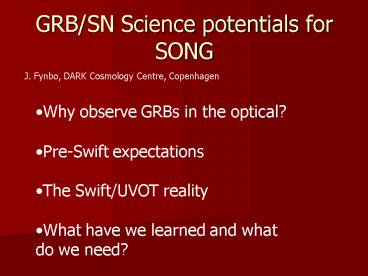GRBSN Science potentials for SONG PowerPoint PPT Presentation
1 / 22
Title: GRBSN Science potentials for SONG
1
GRB/SN Science potentials for SONG
J. Fynbo, DARK Cosmology Centre, Copenhagen
- Why observe GRBs in the optical?
- Pre-Swift expectations
- The Swift/UVOT reality
- What have we learned and what do we need?
2
HR-diagram for cosmologists
GRBs come from up here
High mass
giants live here
L
WDs live here
Low mass
T
3
(No Transcript)
4
A Generic GRB Fireball
UV/opt/IR/radio
gamma-ray
gamma-ray X-ray UV/optical IR mm radio
central photosphere internal
external shocks engine
(shocks)
(reverse) (forward)
5
Why Is Early Afterglow Essential?
- Diagnose the composition of the fireball ejecta
(Late afterglow is the emission from the medium) - Diagnose the immediate environment of GRBs (ISM
or wind? Density clumps? etc) - Diagnose the emission site of GRB emission
(bridge between the prompt emission phase and
afterglow phase) - Diagnose the central engine ativity of the
fireball - FIND THE OPTICAL AFTERGLOW AND HENCE GET A
SUB-ARCSEC POSITION
6
GRB Composition
- Baryonic component
- Protons and electrons
- Neutrons
- Magnetic fields (Poynting flux)
- Answer from Early Afterglows!
7
Early optical afterglow lightcurves(Zhang,
Kobayashi Meszaros, 2003)
8
GRB 990123 (z1.60)
R9!
Zhang, Kobayashi Meszaros, 2003
9
A more typical example XRF03072330723
D1.5m _at_ t(xrf)4.17hr DSS 2 red
10
(No Transcript)
11
Interpretation Supernova
12
Pre-Swift expectations
Fox et al. (2003)
13
(No Transcript)
14
Swift Instruments
- Burst Alert Telescope (BAT)
- CZT detectors coded aperture
- Most sensitive gamma-ray imager ever
- X-Ray Telescope (XRT)
- Arcsecond GRB positions
- CCD spectroscopy
- Jet-X mirrors, XMM Detectors
- UV/Optical Telescope (UVOT)
- Sub-arcsecond imaging Finding chart
- Grism spectroscopy
- 24th mag sensitivity (1000 sec)
- Copy of XMM OM
UVOT
BAT
XRT
Spacecraft
Spacecraft
15
Gehrels et al. (2004)
- The UVOT will provide positions of lt 0.3
arcsec accuracy by using background stars to
register the field. This position will give
unique host galaxy identifications and allow
later comparison with HST fields to determine the
bursts position within the galaxy. - In some events, there may be no optical
afterglow visible due to dust extinction
surrounding the GRB site (Lamb 2003) or Lyman
cutoff of a high redshift event. This is not
likely to occur often with UVOT observing to
sensitivities of 24th magnitude immediately
following the burst, as described below, but when
it does occur it will indicate a high priority
GRB. In such cases, the XRT 5.0 arcsec positions
will be crucial, allowing unique identification
of the candidate galaxy down to mR?26 and rapid
ground-based IR follow-up.
16
The Swift reality
- UVOT started to follow-up on GRBs on a regular
basis around February 2005. - So far it has localised about 100 GRBs (2 per
week, z0.033-6.29). The XRT has found X-ray
afterglow for gt90, but no optical afterglow for
gt75 (Vgt19 at 60-100 sec). - The brightest UVOT detection so far is about V14
at 100sec (050801).
17
Some of the Swift bursts we have studied...
18
Recent nearby burst 060218
19
Recent short burst 060313
?
20
GRBs as probes
21
What have we learned?
- Most GRBs are not very bright at early (lt100sec)
times! - UVOT is not sufficient (at least with its current
observing strategy) to provide sub-arcec
positions or monitoring of the early optical
afterglow phase for most GRBs - We need to reach Rgt20 at 100sec to probe new
territory
22
What GRBs could do for SONG
What we need from SONG to make a difference
- Vgt20 at 100sec
- Robotic response
- I filter to probe the highest redshifts?
- Continuous coverage
- Probe also the high mass end of the HR diagram!
- Broaden the science case
- Greater public appeal?
- Real big game hunting!

